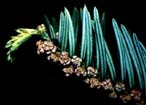
New and mature foliage, and active staminate strobili on an ornamental specimen [C.J. Earle, May-1999].
Common Names
Inugaya, Japanese plum yew (4), cow's-tail pine (5). Var. nana: Hani-inugaya (4).Taxonomic notes
Syn: Taxus harringtonii Knight ex J. Forbes 1839; C. drupacea Sieb. & Zucc. 1846; C. pedunculata Siebold & Zucc. 1846; C. drupacea var. pedunculata (Sieb. & Zucc.) Miq. 1867; C. drupacea var. harringtonii (Knight ex J. Forbes) Pilger 1903; C. harringtonii var. drupacea (Sieb. & Zucc.) Koidz. 1930. Two varieties, the type and nana (Nakai) Rehder 1941 (3). Some authors place C. koreana and C. sinensis in synonymy, and because of this, as well as its long horticultural history, it is the species of Cephalotaxus most often encountered in the literature and, in the West, in cultivation.Description
The following description was applied to var. drupacea, which, as noted above, is here placed in synonymy with the type variety: "A short, up to 10 m high tree or a bush with spreading branches. Crown broadly rounded. Bark gray, peeling longitudinally in thin strips. Shoots green when young, later red-brown. Needles in 2 ranks, dense, spreading outwards and upwards, 2.5-3.5 cm long, 2-3 mm wide, distinctly acuminate, glossy, with 2 light stomata bands below. 'Fruit' ovate, about 3 cm long, on a 6-12 mm long stalk. Flowers appear in March and April, and fruit ripens in September; out of 12 chromosomes, one has a subterminal centromere, and the others median or submedian centromeres; subterminal chromosome has a satellite on its short arm (Mehra and Khoshoo, 1956)" (5). Var. nana has shorter and more slender needles than the type, the fruits are smaller, and the plants are shorter with a more upright, suckering habit; it spreads by layering (4).Range
Japan: Kyushu to Hokkaido, specifically Hondo, pref. Chiba, Mt Kiyosumi, Amatsu-machi, Awa-gun, prov. Awa; Nagasaki; Hiroshima pref. (2); also in parts of NW China and Korea (4). Var. nana found in E Honshu & Hokkaido, typically on seaside cliffs and in mountainous areas (4). Thrives in partial shade on deep, rich soils (5).Big Tree
In 1916, the great plant-hunter E.H. Wilson reported"The largest I saw grow in the rich forests at the foot of Higashi-Kirishima [in Kyushu] ... I saw many trees from 8 to 10 m tall with ... wide-spreading branches forming broad rounded crowns" (4).Oldest
Dendrochronology
Ethnobotany
The most popular Cephalotaxus in ornamental use, with several described cultivars that vary in growth habit, shade tolerance, and cold tolerance (USDA Zones 5 to 9) (4).Observations
Remarks
Named for the Earl of Harrington, one the the species' first European fanciers (6).As var. drupacea, it is listed as threatened in Viet Nam by the World Conservation Monitoring Centre.This was the first species of Cephalotaxus found and described by western plant hunters, and is still the one most commonly seen in cultivation (4).
Citations
(1) Silba 1986.(2) Stockholm Museum of Natural History.
(3) Farjon 1998.
(4) Kim E. Tripp. 1995. Cephalotaxus: the plum yews. Arnoldia 55(1): 24-39.
(5) Vidakovic 1991.
See also:
E.H. Wilson. 1916. The conifers and taxads of Japan. Publications of the Arnold Arboretum. Cambridge: University Press.
[Cephalotaxus] [Cephalotaxaceae] [home]
This page is from the Gymnosperm Database
URL: http://www.geocities.com/~earlecj/ce/ce/harringtonia.htm
Edited by Christopher J. Earle
E-mail:earlecj@earthlink.com
Last modified on 10-Jul-1999